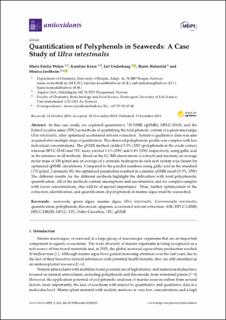| dc.description.abstract | In this case study, we explored quantitative 1H NMR (qNMR), HPLC-DAD, and the Folin-Ciocalteu assay (TPC) as methods of quantifying the total phenolic content of a green macroalga, Ulva intestinalis, after optimized accelerated solvent extraction. Tentative qualitative data was also acquired after multiple steps of purification. The observed polyphenolic profile was complex with low individual concentrations. The qNMR method yielded 5.5% (DW) polyphenols in the crude extract, whereas HPLC-DAD and TPC assay yielded 1.1% (DW) and 0.4% (DW) respectively, using gallic acid as the reference in all methods. Based on the LC-MS observations of extracts and fractions, an average molar mass of 330 g/mol and an average of 4 aromatic hydrogens in each spin system was chosen for optimized qNMR calculations. Compared to the parallel numbers using gallic acid as the standard (170 g/mol, 2 aromatic H), the optimized parameters resulted in a similar qNMR result (5.3%, DW). The different results for the different methods highlight the difficulties with total polyphenolic quantification. All of the methods contain assumptions and uncertainties, and for complex samples with lower concentrations, this will be of special importance. Thus, further optimization of the extraction, identification, and quantification of polyphenols in marine algae must be researched. | en_US |

